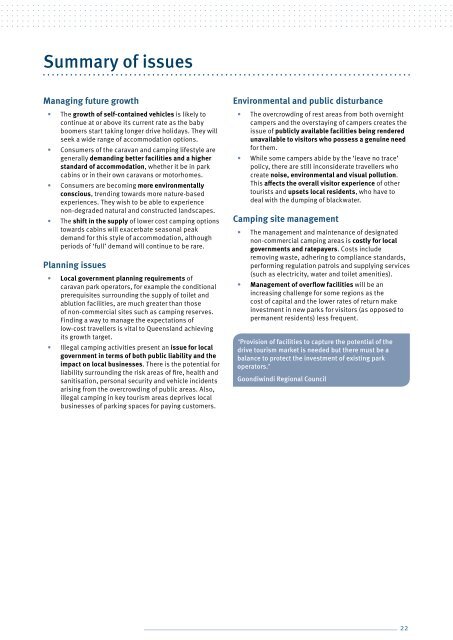qdts-camping-options-toolkit
qdts-camping-options-toolkit
qdts-camping-options-toolkit
You also want an ePaper? Increase the reach of your titles
YUMPU automatically turns print PDFs into web optimized ePapers that Google loves.
Summary of issues<br />
Managing future growth<br />
• The growth of self-contained vehicles is likely to<br />
continue at or above its current rate as the baby<br />
boomers start taking longer drive holidays. They will<br />
seek a wide range of accommodation <strong>options</strong>.<br />
• Consumers of the caravan and <strong>camping</strong> lifestyle are<br />
generally demanding better facilities and a higher<br />
standard of accommodation, whether it be in park<br />
cabins or in their own caravans or motorhomes.<br />
• Consumers are becoming more environmentally<br />
conscious, trending towards more nature-based<br />
experiences. They wish to be able to experience<br />
non-degraded natural and constructed landscapes.<br />
• The shift in the supply of lower cost <strong>camping</strong> <strong>options</strong><br />
towards cabins will exacerbate seasonal peak<br />
demand for this style of accommodation, although<br />
periods of ‘full’ demand will continue to be rare.<br />
Planning issues<br />
• Local government planning requirements of<br />
caravan park operators, for example the conditional<br />
prerequisites surrounding the supply of toilet and<br />
ablution facilities, are much greater than those<br />
of non-commercial sites such as <strong>camping</strong> reserves.<br />
Finding a way to manage the expectations of<br />
low-cost travellers is vital to Queensland achieving<br />
its growth target.<br />
• Illegal <strong>camping</strong> activities present an issue for local<br />
government in terms of both public liability and the<br />
impact on local businesses. There is the potential for<br />
liability surrounding the risk areas of fire, health and<br />
sanitisation, personal security and vehicle incidents<br />
arising from the overcrowding of public areas. Also,<br />
illegal <strong>camping</strong> in key tourism areas deprives local<br />
businesses of parking spaces for paying customers.<br />
Environmental and public disturbance<br />
• The overcrowding of rest areas from both overnight<br />
campers and the overstaying of campers creates the<br />
issue of publicly available facilities being rendered<br />
unavailable to visitors who possess a genuine need<br />
for them.<br />
• While some campers abide by the ‘leave no trace’<br />
policy, there are still inconsiderate travellers who<br />
create noise, environmental and visual pollution.<br />
This affects the overall visitor experience of other<br />
tourists and upsets local residents, who have to<br />
deal with the dumping of blackwater.<br />
Camping site management<br />
• The management and maintenance of designated<br />
non-commercial <strong>camping</strong> areas is costly for local<br />
governments and ratepayers. Costs include<br />
removing waste, adhering to compliance standards,<br />
performing regulation patrols and supplying services<br />
(such as electricity, water and toilet amenities).<br />
• Management of overflow facilities will be an<br />
increasing challenge for some regions as the<br />
cost of capital and the lower rates of return make<br />
investment in new parks for visitors (as opposed to<br />
permanent residents) less frequent.<br />
‘Provision of facilities to capture the potential of the<br />
drive tourism market is needed but there must be a<br />
balance to protect the investment of existing park<br />
operators.’<br />
Goondiwindi Regional Council<br />
22


